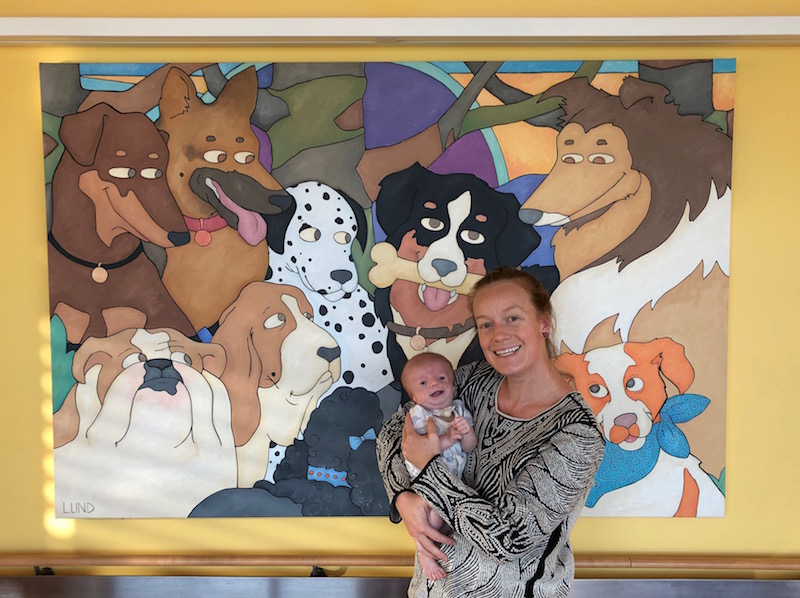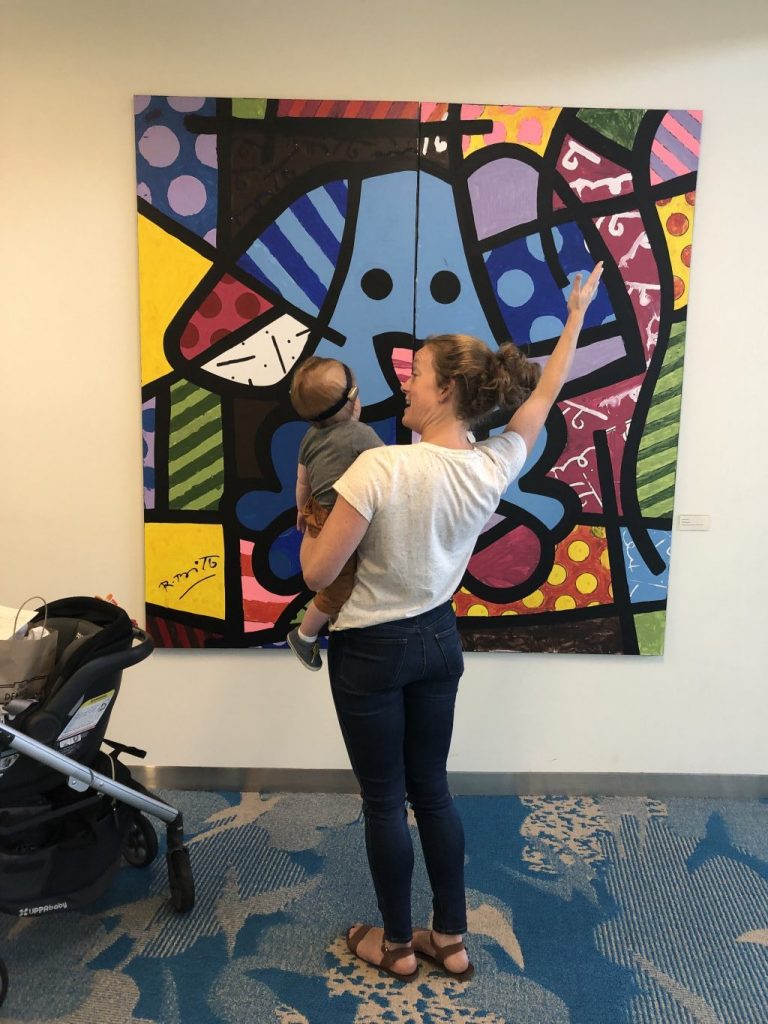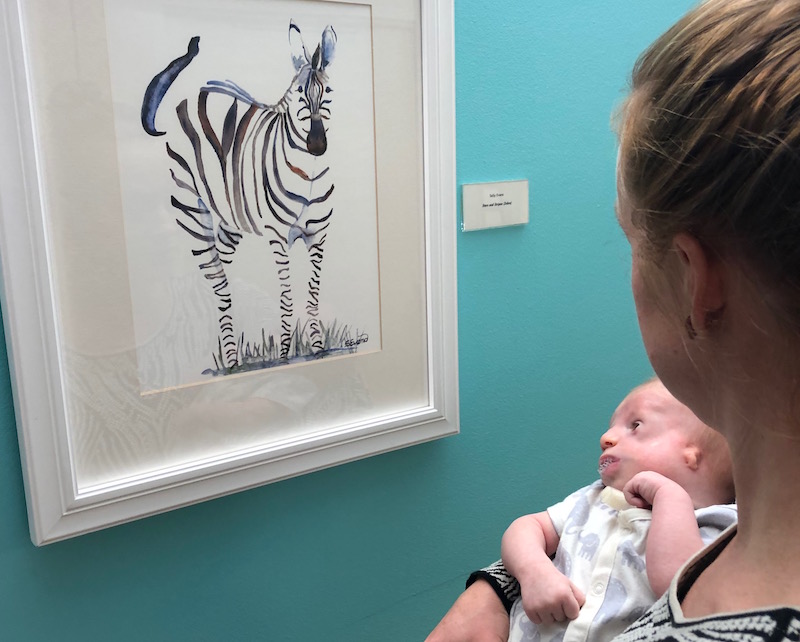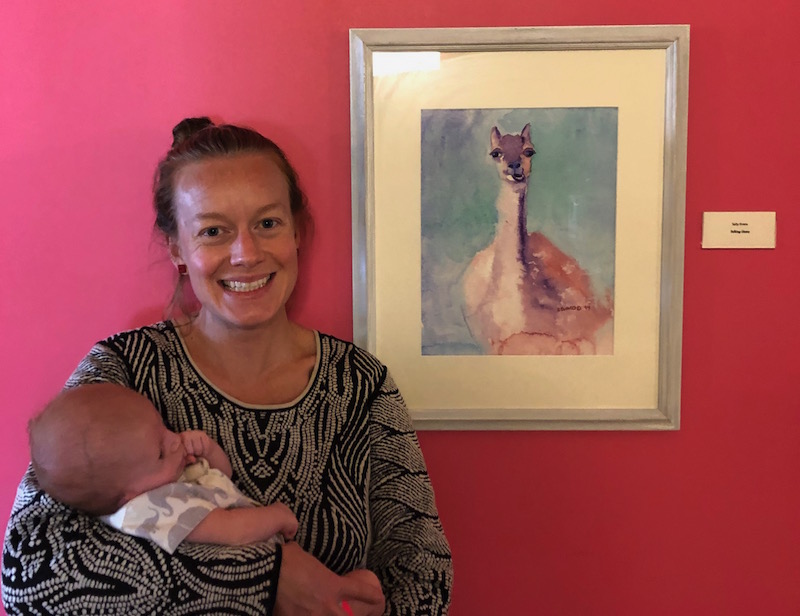I have always known the power of art to heal. My father, an art therapist, instilled in his children a faith to trust the creative process. I grew up in a family of artists and have worked in the arts for over a decade. But it wasn’t until my son was born with a rare genetic syndrome that I truly felt the healing power of art and appreciated art in hospitals.
Where to start? Well there’s Odin.
They say that having children changes you. Well, my son, Odin, flipped us around 180 degrees!
Odin surprised us at birth by having Treacher Collins Syndrome (TCS). It affects the development of the bones and soft tissues in the face. For Odin, this means underdeveloped facial bones, a very small jaw, and no outer ears.
How the hospital became our home.
The early days of Odin’s life were dark, scary and confusing for us.
Odin was rushed to Children’s Hospital Colorado at three days old so that he could get an emergency tracheostomy and spent the next three months in the hospital.
We lived in his hospital room, his nursery at home empty. His room was a revolving door of specialists, flooding us with foreign medical terms. Despite constant information, everything that mattered was unknown—can he breathe? Can he eat? When will he go home?
Everything tracked towards that simple, simple act I took for granted before Odin—going home. To get there, we spent 77 days in the hospital learning about equipment, practicing emergency scenarios, and getting comfortable with what seemed preposterous routines like changing his trach and G-tube…at home, by ourselves!
“When everything seems as if it is hopeless and going nowhere…trust the process.” Shaun McNiff, Trust the Process
This all sounds overwhelming, and it was. But, my dad, the one who taught me the power of trusting the process, was right. Odin brought a big ole’ bag of challenges into the world, but he also brought meaning, light, beauty and joy. And something unexpected that he brought into my life is a new relationship to art.

“Art is a wound turned into light.” — Georges Braque
I’ve already spoken to the ways in which Children’s Hospital Colorado’s art collection helped me stay sane when Odin was an in-patient. Art let me bring the outside world to my son when he couldn’t leave the hospital grounds. You can read the article on Artwork Archive’s blog.
After Odin was discharged, our story with the hospital art collection did not end. We still visit our “home away from home” weekly. Odin sees dozens of specialists, receives weekly therapies and undergoes quarterly procedures.
That’s a lot of time within one space. Thankfully Children’s Hospital Colorado has an extensive and thoughtful collection to distract when we’re overwhelmed, calm when we’re stressed, and entertain when we’re bored. Our weekly visits to Children’s can be less about the medicine and more about new discoveries—like walking into an art museum every week.
I look at art differently now.
I see the art in Children’s Hospital Colorado through the eyes of a one-year old. The hospital’s collection is a feast for Odin’s aesthetic appetite. I marvel at his awe of colors and shapes, watching his eyes dart around the canvas. He stares intently and I can see the gears in his brain moving as he processes the lines and brush strokes.
Because Odin has a conductive hearing loss and limited smell and taste, Odin over-indexes on visuals. His world is silent when he isn’t wearing his hearing devices, but visual art brings vibrancy to his mind and spirit, bouncing energy around in his tiny little body.
I also see the world, and thus art, differently because my son looks different.
Odin’s craniofacial differences have taught me to look beyond the normal and pleasant. I find beauty in unexpected places. Asymmetrical forms catch my eye; conflicting patterns and colors arouse my senses. My eye has shifted, and thus, my perspective and mindfulness has shifted. My mind has been trained by my eye.

Waiting rooms become exploration rooms, for wandering and discovery.
As I mentioned, Odin sees multiple specialists so that means we have appointments that last hours. We wait, a lot. Ever had to preoccupy a one year old for four hours? It’s brutal. So, we walk down the hall of the Special Care wing. Nurses and attendings see a ginger head pop out of room 462 and bob down the hallway looking at the artwork lining the walls. Some stop and look at the artwork with us.
We see new specialists (last week it was cardiology), visit new wings of the hospital (next week it will be radiology), and travel to different campuses (ophthalmology is an hour away). Each space provides us with surprise and delight as we discover new artworks. In our most recent appointment, we found paintings of farm animals. Odin traced the spots of a cow with his finger as I told him about contrast and startled the nurses on the hall with a vociferous “Mooooooo.”
Dogs are Odin’s favorite animal, so he always seems to lead us on a scavenger hunt for the furry canines in every space we occupy. He’ll find the dog in the background of a photograph or in a menagerie of other creatures. I’ll hear the excited slap of his tiny baby palm against his thigh (the ASL sign for “dog”) and see his eyes glue to the work of art.
It’s nice to remember the art, not the prognosis.
Mundane visits are the best. You don’t really want memorable ones. The art brings levity, light, and importantly, distraction. The best days are when we walk out of the hospital chirping away about the shining mosaics we saw in the main lobby rather than the bronchotomy results that say Odin’s trach can’t be removed, yet, his airway is still too small.
Art will help heal us when we return for procedures.
Odin has a long road of surgeries ahead. Kids with TCS can have up to 20 surgeries before they are 16. Fourteen months in, Odin has already had four procedures.
When we return to the 9th floor for his next major surgery, a jaw distraction, I will find comfort in the familiarity of the dog painting down the hall. It is an old friend. I showed Odin that painting when he was just weeks old, when we were living in the room down the hall. I told him about his dog, Juno, who he had yet to meet in front of that painting. Maybe that’s where his love story with dogs began?
And, I’ll show Odin the llama that captivated him at only two months old. We’ll talk about the artworks in a new way. He will point to things that grab his eye. He’ll tell me what he sees—signing colors, animals. We’ll converse in ASL, hands flying.

And when I’m exhausted, art will help me find the way.
Hospitals are exhausting places. Being a parent is exhausting. Medical complexity doesn’t help said exhaustion. Most visits are dreary and sleepy, fueled by coffee in my to-go mug. When I bleary-eyed approach the lobby, I ask myself, “what floor?” And grumble to myself, “we were here last month and the month before, how can I forget what floor occupational therapy is on?” Then it will hit me as we walk towards the elevators, “it’s on the bird floor—where Odin always looks at the eagles.” Art helps me find the way.
Art and Odin have taught me to trust the process.
Sometimes, I’m cranky about an upcoming appointment knowing that I won’t get as much work done for my job at Artwork Archive. But then, I always remember, when sitting in the lobby looking at the other bleary-eyed parents walking through the temporary art exhibit space, that THIS is my work.
My life’s work has been to make art accessible. Odin, daily, viscerally reminds me of how important it is to make the creative process accessible to others. I see David Hayes’ Harlequin being installed in the hospitals sculpture garden, and it reminds me of the work I did back in Boston—running a public art program. I see grandmothers knitting in the lobby, reminding me of the crafting company that brought us out to Denver years ago. Above all, Odin grounds me in the work we do at Artwork Archive—helping institutions and artists manage their art, including some of my favorite partners, hospital art collections.
Odin has reminded me that the universe is small. That art connects us. That art heals. That art is part of the process, and that process, I have to trust.
The author is the Head of Growth at Artwork Archive. Artwork Archive provides artists, collectors, and organizations with powerful tools to manage their artwork, career or collection. You can find additional art news, resources, tips and advice here.
Before Artwork Archive, Elysian ran a public art program for New England Foundation for the Arts, made online art classes for Craftsy (acquired by NBC and now Bluprint), and received her Masters in Public Humanities from Brown University. She is also a contributing writer to Art New England, Public Art Review and Americans for the Arts.


